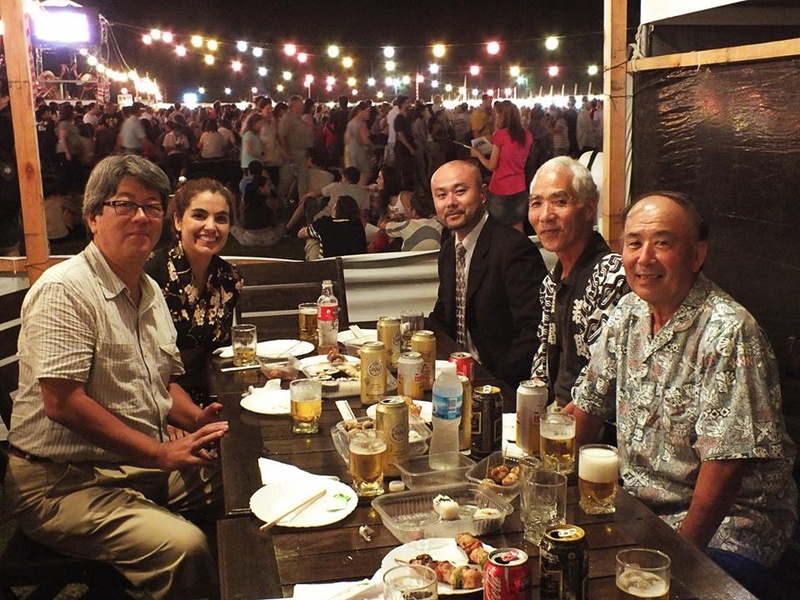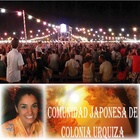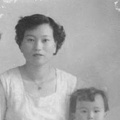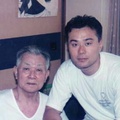Read Part X (Part 1) >>
The day after the event the following note appeared in newsprint that will be read below:
El Día Newspaper: “CROWD AT THE BON ODORI”
Japanese dance came to the stage in La Plata (in: www.eldia.com or printed edition Nº313 of the year CXXXI page 32, back cover)
Thousands of people participated last night in the traditional oriental festival that was reissued on a property in Colonia Urquiza. Once again, the traditional Japanese dance festival that takes place on the second Saturday of January brought together a crowd of visitors yesterday. To the rhythm of the taikos - drums - thousands of people participated in the dance that takes place around the yagura - tower -, were entertained with Japanese games and tried the typical foods of that ancient culture. As usual, from the early hours of dusk, the surroundings of the Colonia Urquiza property -186 and 482 - where the Bon Odori takes place, began to fill up with cars and buses coming from the Region and other parts of the Province. Hundreds of lanterns, stalls packed with Japanese products, a gastronomic sector and the dance floor that surrounded the tower from which the drums were played, created the festive atmosphere. The atmosphere invited visitors to make their own a Buddhist celebration that remembers the ancestral spirits, who according to tradition, return to their homes to reunite with their families. According to that belief, popular religious dance originated to give comfort to the spirit of the deceased and yesterday, men and women dressed in traditional Japanese costumes, danced to the beat of traditional music and were models for those who wanted to imitate their cadence. The La Plata Japanese Association has been in charge of organizing the event since 1999 and, as reported, the proceeds are subsidized by the Japanese School in the Region. Keeping the tradition alive and awakening the desire for visitors to return the following year are some of the objectives for which each area works, whether it is the parking, entrance, security, food, beverage, information or of lights. Already during the last hours before the festival, the movement was incessant. Those who dedicated themselves to the preparation of the yakitori (chicken skewer) started the day before with washing the vegetables, then the kitchen assistants with sharp boards and knives dedicated themselves to cutting onions, bell peppers and the chicken. In another sector, takoyaki - octopus balls - were made. The dance was also rehearsed, the stands were set up and the elements with which the fireworks show was set up, one of the most anticipated segments of the meeting, were arranged. The organizers highlighted the commitment assumed by those who worked at Bon Odori, without pursuing any personal gain in return, with a great sense of cooperation, solidarity and, fundamentally, with the idea of establishing a link with tradition based on respect for the older people and the recovery of culture. Ancient tradition Bon Odori is a traditional Japanese dance festival; It is celebrated every summer and is organized locally in each city.
Interviews with visitors who came for the first time or regulars , impressions of attendees during the festival:
Reina Guillén de Duarte: “Very happy to have been able to experience this party thanks to the fact that I came to visit my cousin from Paraguay, the truth is it was worth it, I have a lot to tell my sisters and grandchildren, I take joy and wonderful memories with me.”
Víctor Manuel Duarte Guillén: “Never in Asunción, Paraguay, have I seen such a beautiful show, so organized, the truth is that it was a unique experience.”
Akiko T: “I have been living in Lima, Peru for years, and my memories of Bon Odori have always been very good. This year I was able to experience a wonderful party and meet again with my family and friends.”
Gabriela Z. and Mario Z. (Lyrical singers): “Very happy to be able to be and enjoy this party.”
Eduardo Luis Bórquez (from radio Rocha): “Beautiful experience of getting to know BON ODORI, that peculiar part of Japanese Folklore. Subtlety made into a woman in the Oriental Ladies present. Wholesale joy and expressiveness in dance and music.
That beautiful January night we learned here in the West, a little of that beautiful and distant culture that came from the mists of time. Popular expression shared with the family. We Platenses enjoy the delights of typical Japanese dishes!!!
Beautiful experience to be repeated in 2016!!! “My congratulations to the Organizers of BON ODORI for the quality achieved in the 16th edition!!!!”
Leonardo Gauna Illustrator: "An ideal night for the palate, the eyes, the rhythm and the understanding of a beautiful and extraordinary culture."
Javier Alberto Zila (photographer and designer): “I've been going since the first day but I always see something new that amazes you, an ornament, the rhythm, a face, the whole thing itself”!
Guillermo Zila (photographer and restaurateur): “I think the Bon Odori leaves evidence of how much this Japanese community, which arrived in Argentina in the 1950s, maintained its roots, its customs, including an immense gratitude for the new soil and that is reflected They instilled it in their descendants born in Argentina. What I see in Bon Odori since it began is a demonstration that the culture and its history are still alive, awake, and constantly revealing their meaning to people who are attracted to this event year after year. A totally family event, pleasant, relaxed and at the same time emotional.”
Héctor Folino (photographer and restaurateur): “I thought it was something very interesting, very nice... But at times the number of people made it a little impossible to enjoy all the splendor of the event. Surely they didn't expect so many people... it's still an experience to repeat.”
Marcos González (musician): “We arrived really late, in the end. We left home at 8:00 p.m. and we were able to enter the property at 10:15 p.m. newly!!! The line of cars there was impressive, from the 520 roundabout it got stuck and it took us an hour and a half to leave the car. We saw little of the percussion groups. Beyond that, I liked the fireworks, the warmth of the people's treatment, the stalls, and the variety and quality of the food. We tried everything. And we watched as they danced across the screen. What I didn't like was that it was soooo full, a lot of people.”
Cecilia A. (music): “I can tell you that I loved the celebration; Although I am not very soaked, I know that it is danced in honor of the ancestors, and there is an impressive energy all the time. It was a discovery last year; get closer to all this culture, and there we decided to return. Beautiful encounter with people who begin to vibrate at the same frequency. What can I tell you......we look forward to the next one!
Roberto Daniel C. (photographer): “I recommended that you wear comfortable shoes since the entire event takes place on dirt and grass, as well as bringing mosquito repellent, an easy-to-wear coat in case it gets cold at night, and a desire to try some Japanese delicatessen and fundamentally have an open mind, eager to learn about other customs and share time without time, participating in traditional circular dances around a central tower (Yagura), and to the beat of music and Taiko “...
Rosa Lacewiscki (photographer of Making Focus): "It was a beautiful experience, sharing with almost 50 photographers, a celebration where east and west come together. Customs, foods, colors, disciplines... participating in the dances, with their ritual sense, of those of us who participated without distinction of age or sex, it was moving and very enriching. We are still sharing the images and commenting on the experience. And from now on, we will remain attentive to participate again next year. Thanks to Irene, for her comments on our photos, which allowed us to contextualize them and give them even more meaning."
Ricardo C. (musician and doctor): “I thought I arrived at the worst time, I couldn't leave the car in a good place, it was after 9:00 p.m. We traveled little and I didn't enjoy the whole show. The fish thing was very nice (where everyone can fish with some nets and take home the trophy). I went with several friends, that's bad, because you can't agree on what to see, what to eat or what to drink. I really want to return next year and sooner, and those who went with me were left wanting more.”
Tsuyoshi Tamura (Brazil correspondent The Asahi Shimbun) “In Urquiza I had a very nice time with you. It was a very interesting experience. I was very impressed by the bon odori, the traditional dance of Japan, so many people gathered and having a lot of fun until dawn. It was a magnificent landscape, while in the world there is massacre or terrorism between different peoples.”
In short, both the newspapers and the radio stations that commented and announced the Bon Odori of Colonia Urquiza, once the event was over, wrote about the success achieved and promoted the 17th edition of the Bon Odori 2016. The spontaneous interviews reflect the enthusiasm , the positive experience and very little tell us about difficulties, which are part of suggestions, to be taken into account by the Bon Odori Organizing Commission, for the next festival.
© 2015 Irene Isabel Cafiero







